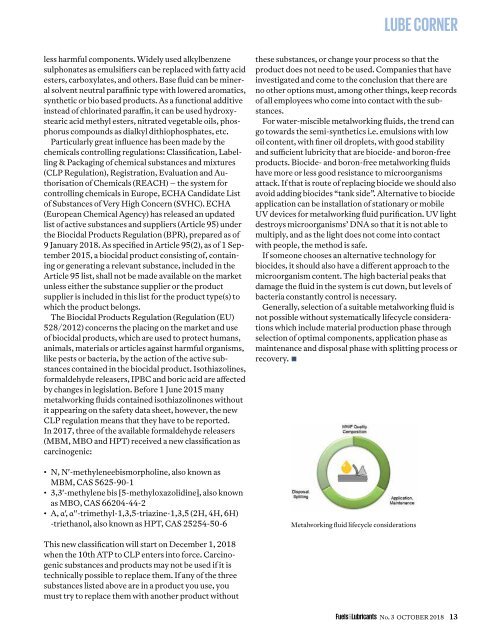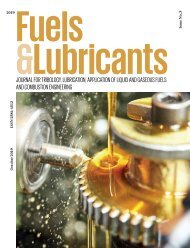Fuels & Lubricants Magazine
Issue No. 3, October 2018
Issue No. 3, October 2018
Create successful ePaper yourself
Turn your PDF publications into a flip-book with our unique Google optimized e-Paper software.
LUBE CORNER<br />
less harmful components. Widely used alkylbenzene<br />
sulphonates as emulsifiers can be replaced with fatty acid<br />
esters, carboxylates, and others. Base fluid can be mineral<br />
solvent neutral paraffinic type with lowered aromatics,<br />
synthetic or bio based products. As a functional additive<br />
instead of chlorinated paraffin, it can be used hydroxystearic<br />
acid methyl esters, nitrated vegetable oils, phosphorus<br />
compounds as dialkyl dithiophosphates, etc.<br />
Particularly great influence has been made by the<br />
chemicals controlling regulations: Classification, Labelling<br />
& Packaging of chemical substances and mixtures<br />
(CLP Regulation), Registration, Evaluation and Authorisation<br />
of Chemicals (REACH) – the system for<br />
controlling chemicals in Europe, ECHA Candidate List<br />
of Substances of Very High Concern (SVHC). ECHA<br />
(European Chemical Agency) has released an updated<br />
list of active substances and suppliers (Article 95) under<br />
the Biocidal Products Regulation (BPR), prepared as of<br />
9 January 2018. As specified in Article 95(2), as of 1 September<br />
2015, a biocidal product consisting of, containing<br />
or generating a relevant substance, included in the<br />
Article 95 list, shall not be made available on the market<br />
unless either the substance supplier or the product<br />
supplier is included in this list for the product type(s) to<br />
which the product belongs.<br />
The Biocidal Products Regulation (Regulation (EU)<br />
528/2012) concerns the placing on the market and use<br />
of biocidal products, which are used to protect humans,<br />
animals, materials or articles against harmful organisms,<br />
like pests or bacteria, by the action of the active substances<br />
contained in the biocidal product. Isothiazolines,<br />
formaldehyde releasers, IPBC and boric acid are affected<br />
by changes in legislation. Before 1 June 2015 many<br />
metalworking fluids contained isothiazolinones without<br />
it appearing on the safety data sheet, however, the new<br />
CLP regulation means that they have to be reported.<br />
In 2017, three of the available formaldehyde releasers<br />
(MBM, MBO and HPT) received a new classification as<br />
carcinogenic:<br />
• N, N'-methyleneebismorpholine, also known as<br />
MBM, CAS 5625-90-1<br />
• 3,3'-methylene bis [5-methyloxazolidine], also known<br />
as MBO, CAS 66204-44-2<br />
• A, α', α''-trimethyl-1,3,5-triazine-1,3,5 (2H, 4H, 6H)<br />
-triethanol, also known as HPT, CAS 25254-50-6<br />
these substances, or change your process so that the<br />
product does not need to be used. Companies that have<br />
investigated and come to the conclusion that there are<br />
no other options must, among other things, keep records<br />
of all employees who come into contact with the substances.<br />
For water-miscible metalworking fluids, the trend can<br />
go towards the semi-synthetics i.e. emulsions with low<br />
oil content, with finer oil droplets, with good stability<br />
and sufficient lubricity that are biocide- and boron-free<br />
products. Biocide- and boron-free metalworking fluids<br />
have more or less good resistance to microorganisms<br />
attack. If that is route of replacing biocide we should also<br />
avoid adding biocides “tank side”. Alternative to biocide<br />
application can be installation of stationary or mobile<br />
UV devices for metalworking fluid purification. UV light<br />
destroys microorganisms’ DNA so that it is not able to<br />
multiply, and as the light does not come into contact<br />
with people, the method is safe.<br />
If someone chooses an alternative technology for<br />
biocides, it should also have a different approach to the<br />
microorganism content. The high bacterial peaks that<br />
damage the fluid in the system is cut down, but levels of<br />
bacteria constantly control is necessary.<br />
Generally, selection of a suitable metalworking fluid is<br />
not possible without systematically lifecycle considerations<br />
which include material production phase through<br />
selection of optimal components, application phase as<br />
maintenance and disposal phase with splitting process or<br />
recovery.<br />
Metalworking fluid lifecycle considerations<br />
This new classification will start on December 1, 2018<br />
when the 10th ATP to CLP enters into force. Carcinogenic<br />
substances and products may not be used if it is<br />
technically possible to replace them. If any of the three<br />
substances listed above are in a product you use, you<br />
must try to replace them with another product without<br />
<strong>Fuels</strong>&<strong>Lubricants</strong> No. 3 OCTOBER 2018 13







